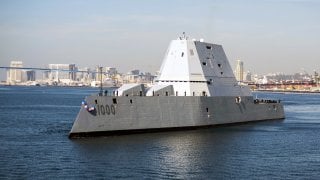Does the U.S. Navy Have a Strategy Problem?
Former deputy undersecretary of the Navy and current Hudson Institute analyst Seth Cropsey has aimed a broadside at the U.S. sea services’ latest maritime strategy. Unfortunately, Cropsey’s broadside sails well wide of the mark.
And yet they still left operational details vague—and justly so.
Geopolitics is more complex nowadays. Challengers have proliferated around the Eurasian rimlands in recent years. Accordingly, the framers of Advantage at Sea survey the strategic seascape. In contrast to the Cold War, when the Soviet Union was the foremost challenger by far, the United States and its allies confront multiple potential foes. The sea services must set and enforce priorities. That demands self-discipline. Nor do these antagonists entertain more or less plain goals such as overrunning NATO-Europe. They covet many things. Accordingly, the Triservice Maritime Strategy mulls likely challengers, names a primary antagonist, and ranks the rest. “The People’s Republic of China represents the most pressing, long-term strategic threat,” the framers say. Russia comes next, while Iran and North Korea are troublesome but subsidiary threats.
China, the next big thing in strategic competition, harbors goals all along the Asian seaboard. In this age of martial complexity, Advantage at Sea takes a clear stance on priorities—and in the bargain fulfills one of the paramount goals of any strategy. At the same time it remains rightly noncommittal about particular methods for executing the strategy. Admiral Watkins would smile.
Second, the triservice strategy announces that U.S. maritime forces are in embattled regions to stay, and that they will combine amphibious forces with the fleet to deny an antagonist control of the sea—and frustrate its strategic aims—while positioning themselves to wrest away control for themselves. Though not by name, the service chiefs ransack the Corbettian playbook. After all, says the British theorist, “The paramount concern . . . of maritime strategy is to determine the mutual relations of your army and navy in a plan of war.” The triservice strategy does just that. Sea-service chiefs vow to “combine distributed fleet operations and mobile, expeditionary formations with sea control and sea denial capabilities.” Marines will take an active hand in supporting the fleet from Pacific islands and assailing hostile shipping and aircraft. No longer will marines be, in effect, cargo deposited on foreign shores.
Nor, it bears mentioning, is the Triservice Maritime Strategy a standalone document. In fact, it states that operational details appear in “Naval Service concepts—Distributed Maritime Operations, Littoral Operations in a Contested Environment, and Expeditionary Advanced Base Operations—that combine the effects of sea-based and land-based fires, enabling our forces to mass combat power at times and places of our choosing.” These affiliated concepts make it clear that top commanders mean to redistribute combat power from a few major platforms to many small, fleet-of-foot craft that operate around and on Pacific islands—chiefly along Asia’s first island chain—to prevent China’s navy from using the sea to accomplish goals such as conquering Taiwan or the Senkaku Islands.
A fleet whose firepower is dispersed among many platforms is a hardy fleet. It can absorb losses and fight on.
And third, the strategy serves notice that time will not be on the foe’s side in wartime. China’s People’s Liberation Army envisions executing short, sharp wars around the Asian periphery to allow Beijing to get its way before others can intercede in force. Advantage at Sea tells everyone from Congress to Beijing that in the event of war the U.S. sea services will not be evicted from the Western Pacific. Instead they will stand in, balking China’s strategy while building up strength sufficient to prevail. China will stare a long war in the face where it craved a short one. Again, this is vintage Corbett: dispute command, win command, exploit command—and win.
If this is not maritime strategy, nothing is.
Cropsey’s chief gripe seems to be that Advantage at Sea doesn’t set forth a script explaining in depth how commanders will put maritime means to work attaining strategic and political ends. But refraining from specifics is a good thing. Any strategist worth his salt will tell you that script-writing—positing a detailed sequence of events in which the enemy plays its part the way friendly commanders expect it to—is a fallacy of the first order. No enemy complies with our wishes. Its leadership has every incentive to flout the script and ruin our production. What Cropsey apparently wants out of a strategy statement is precisely what service chieftains should avoid putting in.
The ghosts of Sam Huntington and James Watkins can rest easy: the U.S. sea services are not floundering around with no strategic concept to guide them.
James Holmes is J. C. Wylie Chair of Maritime Strategy at the Naval War College. The views voiced here are his alone.

